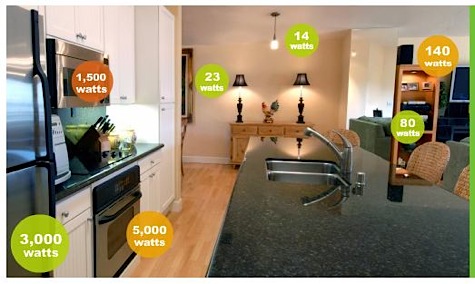A while back, I wrote about how we were able to lower our utility bills with new appliances. As part of my push to try to save money so that I could afford taking the risk of self employment as a full time blogger, my spouse and I focused on the recurring cost of energy in our household. And yes, by the looks of it, our investments in new Energy Star appliances (a $1,200 refrigerator and an $800 washer) should be close to paying themselves off by now, after a couple of years of lower utility bills (also thanks to some stricter rules for energy consumption at home). The great news is that we’ve been experiencing at least 25% in cost savings since our decision to buy these energy-efficient appliances in late 2007.
So I thought I’d follow up on this cost savings strategy today and see just how well Energy Star appliances can work out for you. It may be a good idea to first determine how much you are spending on energy. To help you out, here’s a neat idea called Greenbox, a software program that allows you and your utility company to monitor your electricity usage; Forbes recently ran an article on it.
 Image from Greenbox
Image from Greenbox
Using Energy Star Appliances To Save On Utility Costs
As my personal story shows, if you’ve got aging appliances, performing an Energy Star upgrade could reduce your energy consumption by quite a lot. Here’s a little background on it:
The Energy Star program began back in the nineties as a way to help consumers choose products that are more energy efficient. In addition to home appliances, we can find Energy Star labels for common products like office equipment, lighting, and even home electronics, as well as some new homes (just check this green home) and commercial properties. With guidelines provided by the Environmental Protection Agency and the Department of Energy, you can just look for the blue Energy Star label instead of taking a calculator with you to see if the model you want is energy efficient!
So how about we take a look at a few of these appliances and see how they score for energy efficiency?

Refrigerators & Freezers
As Lowe’s points out, the refrigerator uses the most energy of our household appliances because it runs 24 hours a day. According to the Energy Star site, if you replaced a refrigerator you purchased in 1990 with an Energy Star model, you’d save enough energy to run your lights for four months. Also, today’s Energy Star refrigerators are supposed to use 20% less energy than required by current federal standards and 40% less than the conventional models from as recently as 2001.
As an example, replacing a five-year-old Frigidaire with a similar Energy Star model would cost $548, while the estimated yearly operating cost is $38.
Dishwashers
Now here’s what the Energy Star site says about today’s compliant dishwasher models: they actually use less hot water than conventional models and 41% less energy than the federal standard.
Looking at the specs for this Maytag dishwasher, I can see that it’s Energy Star compliant. I’ve checked a few dishwashers, and a scan of their Energy Guide information shows that a dishwasher can typically cost between $400 and $700; it will also cost you about $34 a year to operate. Could it be time to fire our current team of dish washing relatives and to look into an Energy Star portable dishwasher?
Clothes Washers
I read that an Energy Star clothes washer uses 40% less energy and up to 60% less water than its conventional counterparts. Energy Star also reports that we can save up to $550 over the lifetime of an energy efficient model. While that’s the claim, I actually think those savings are underestimated, as evidenced by my own experience. But then again, my savings also factor in cost cuts due to my household’s stricter rules for energy use at home.
As an example, a Whirlpool Duet model is supposed to save you 73% water and 77% energy compared to a conventional model made before 2004. That would be awesome for the environment and for your wallet, but its price is pretty hefty at $1595.99! It might only be worth it if you’ve got a big family and a lot of laundry to do!
One other point: I looked for information on energy-saving dryers, but Energy Star doesn’t monitor them because the energy use doesn’t vary much among models.
Air Conditioners
For some of us, A/Cs are the biggest energy users in our home (do you live in Nevada or Arizona?). There was a time here in California when we were subjected to rolling blackouts because of the strain that simultaneous air conditioners were placing on our energy grids during heat waves. An Energy Star compliant air conditioner in each household would help by using 10% less energy than their conventional counterparts. So if you’re looking for cheap ways to keep cool, you may want to consider an Energy Star air conditioner to help beat the heat.
So is a new appliance in the cards for you? if you’re going to replace an old home appliance soon, shopping around for an Energy Star model can save you money in the long term (as it did for me). Look for that blue label, and read the yellow Energy Guide labels as well — they’ll give you estimates on the annual cost of running the appliance and the amount of energy you’d save compared to conventional models. And for added savings, don’t forget to pick up rebates and discounts from retailers who are eager to unload their merchandise in this recession. I certainly got a few hundred dollars’ worth of rebates applied to my purchases, sweetening these “investments” all the more!
With help from contributing writer: Millie Kay G.
Copyright © 2009 The Digerati Life. All Rights Reserved.

{ 7 comments… read them below or add one }
A lot of appliances are really starting to go this route and it’s great. It can save a little bit of energy good for the environment and can save you a little money as well. Everyone getting new appliances should look into this.
There are some other things you can do to reduce your energy usage as well.
1) Replace regular light bulbs with CFLs (compact fluorescent – the twisty bulbs) They can cut wattage significantly
2) Turn down the temp setting on your water heater. If you can’t hold your hand under the faucet while it is running pure hot, you have it too hot. Modern detergents can clean clothes at lower temps and taking cooler showers can be beneficial too. Insulate it as well including the pipes leading out of it.
3) Install a low flow self pressurizing shower head. It will reduce the amount of hot water you use and lower your water bill too.
4) Fill up the fridge and freezer. If you keep your frig/freezer half empty, you put a greater load on it every time you open the door. Fill up two liter bottles with water to take up spare space. Make sure you don’t fill them completely for the ones you put in the freezer. The liquid/solid bottles will hold the cool in the frig/freezer much better than the same volume of air.
Just wanted to let you know that I have included this post in Buddy’s Extra Best post of the Week. I hope the link brings you many new guests.
Great post
Margaret
Such simple changes that can make big differences when added together! Thanks for the tips!
A lot of energystar appliances now have rebates available in certain regions around the country as well. They’re sometimes hard to find but a lot of blogs track that kind of thing. RainbowAppliance.com is coming out with a new blog soon and will be sharing rebate information with consumers to help get people looking for new home appliances and electronics the best deals possible.
The only thing is that some of these Energy Star statistics have been called into question, can we really be sure of the data that is put on there?
Fortunately, there are a lot of ways that can help you save on electricity:
1. Seal the leaks
2. Use your thermostat controls
3. Be wary of seemingly small things
4. Avoid opening the refrigerator door frequently